The customer chose to protect their confidential information
Digital BSS Transformation Project for a Telco Customer

About the Client
Andersen was approached by a B2B/B2C mid-sized Telecom company and mobile network operator. The company provides a set of services that are focused on mobile communications, Internet, and IPTV products. As of today, the company serves more than 10 million users in the European market.
![[object Object] on the map](https://static.andersenlab.com/andersenlab/new-andersensite/bg-for-blocks/about-the-client/austria-desktop-2x.png)
Project overview
Specialists
- 3 Solutions Architects
- 2 BA/SA specialists
- 3 Web Front-end developers (HTML/JavaScript/CSS)
- 3 Web Back-end developers (Java)
- 1 DevOps engineer (AWS)
- 2 QA engineers
- 1 UI/UX designer
- 1 Delivery Manager
Business challenges
The increased competition forced the Telecom company to rethink and redesign their commercial offerings to win clients. It then took more time, money, and resources to extend and maintain such product portfolios. Therefore, some of the customer's operations turned out to be inefficient as they were processed via outdated legacy systems by different vendors. As a result, the company decided to implement a digital BSS transformation project for their business support system and entrusted us to perform an audit of their entire IT architecture.
Among the business challenges faced by the customer, we identified the following:
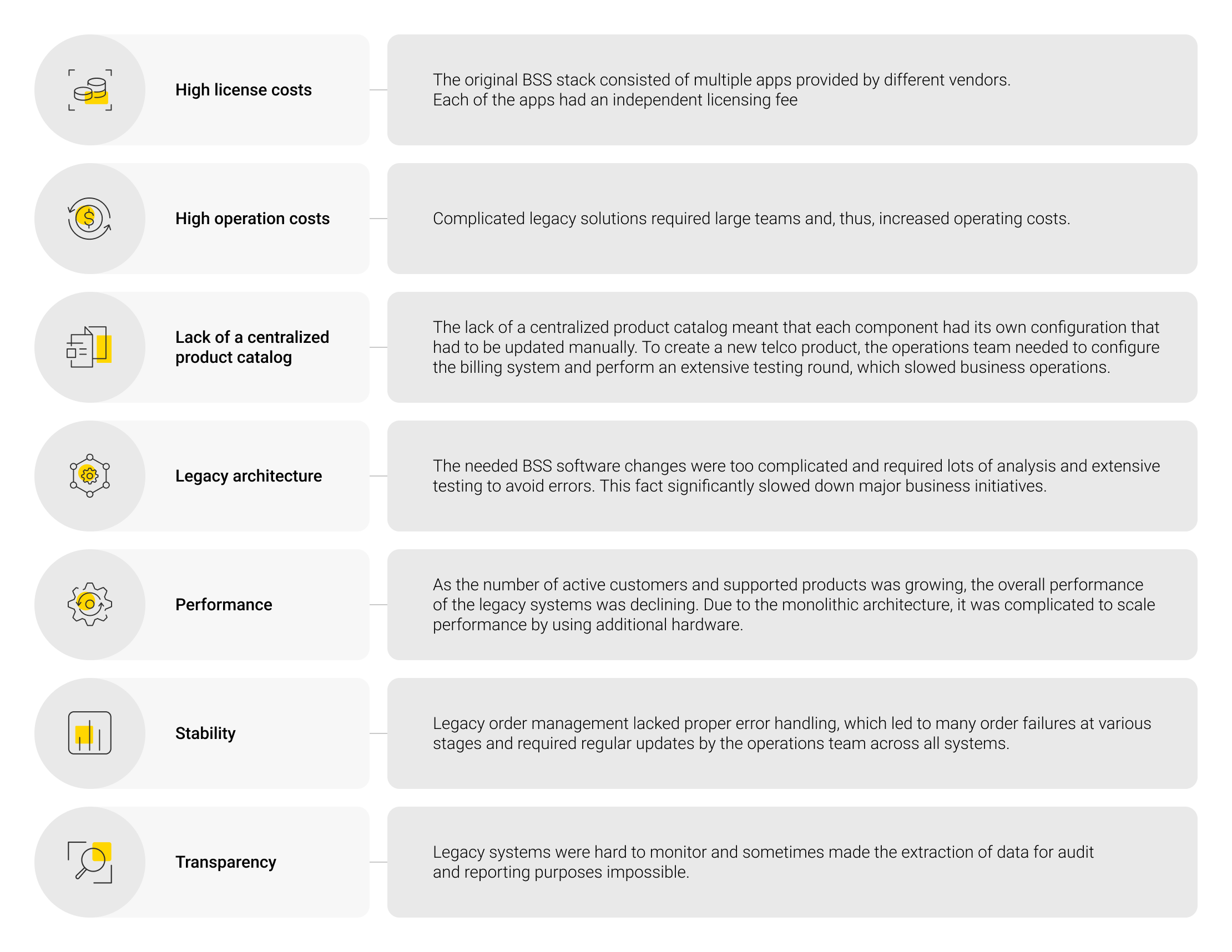
Project goals
The key request from the customer was to modernize their IT architecture so that they could optimize customer services, launch products faster, and reduce operating costs. Andersen's BSS telecom architecture specialists defined more specific goals as follows:
Decreasing costs:
- Lowering license costs by choosing a single BSS vendor that would provide the best-matching end-to-end BSS solutions for Telecom;
- Reducing operations costs by simplifying the solution, improving its stability, and decreasing its support team.
Agility:
- System should have a single unified product catalog is integrated across multiple components, incl. billing, sales/support channels, and customer management;
- System should follow clear architecture guidelines and expose a comprehensible set of APIs that allow to easily extend functionalities of the system;
- Order management should support clear customization points that allow to modify the existing order flows, with little to no code changes needed.
Performance/Stability:
- System should have a microservice-based architecture to simplify its horizontal scaling and improve its performance and scalability;
- Order management should be stable and robust and support a proper retries / rollback logic to ensure the correct state of the customer whenever possible;
- System should follow clear KPIs that consider the time needed for an E2E process completion (e.g. package activation within 5 seconds across systems).
Transparency:
- System should expose its internal data via APIs and events and/or regular dumps to ensure its data is accessible via other components and DWH.
Market trends
The current state of the Telecom market is shaping the distinct demand for holistic, personalized, and fast services. Communication service providers cannot be bogged down by legacy BSS that are simply not designed to cater to an ever-increasing demand for new products and services, as well as incapable of supporting the new revenue and cost models emerging alongside 5G services. Thus, a BSS transformation project is the only viable solution to tackle the challenges of a fast-paced digital landscape.
Solution
Andersen's team of analysts and digital BSS architecture experts reviewed the existing IT architecture and suggested improvements.
After careful consideration and numerous discussions, we came to a conclusion that only a major BSS transformation project, with a complete swap of most of the existing BSS systems, would make it possible to achieve the goals set by the customer. Despite being an extremely complicated process, it would significantly improve the customer's Telecom business perspectives and decrease long-term operational costs.
Due to the customer team's lack of experience in major Telecom transformations, Andersen was asked to assist them in drafting the initial solution architecture, organizing a tender process to select the best matching primary BSS software provider, and supporting the general transformation process.
Tender preparation
The current market offers a broad range of BSS solutions for Telecom, with varying levels of maturity, extensibility, and price. Andersen's knowledge of existing Telecom products and the operator's current IT landscape became crucial when it came to organizing a tender, evaluating the participants, and shaping the ultimate solution.
Requirements matrix
To select an optimal BSS solution, a list of requirements for all affected components needed to be clearly formulated via a requirements matrix.
Andersen's BSS architecture specialists and analysts conducted multiple workshops with the customer's representatives in various departments — business, finance, marketing, etc. — to clearly describe the existing solution, identify which components required transformation, and draft requirements for the new ones.
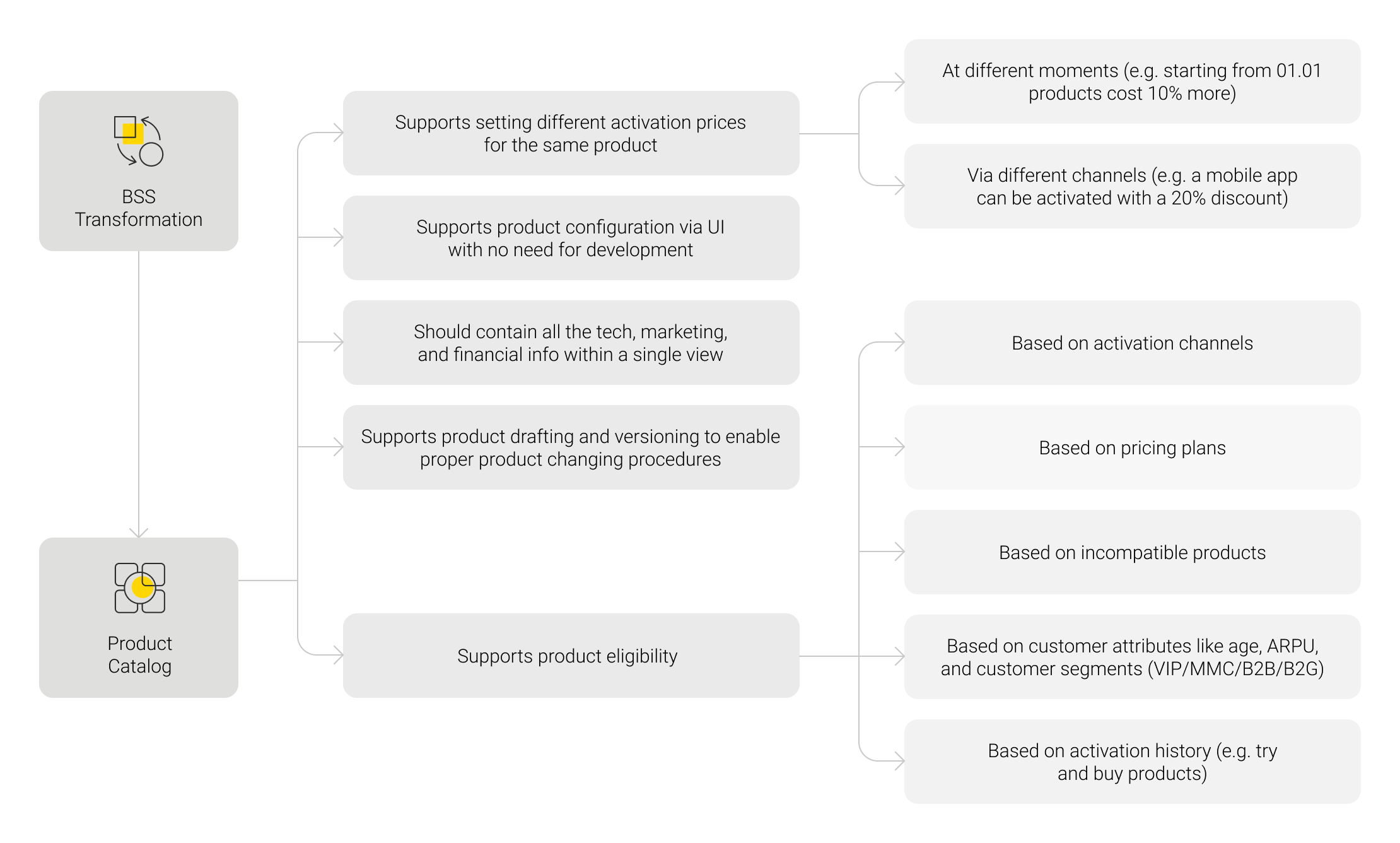
Business processes
Apart from the requirements matrix for specific components, it was essential to ensure the E2E implementation of the needed business processes because such processes usually affect multiple systems simultaneously. The tender preparation stage also included formalizing, describing, and drafting high-level architecture for the operator's processes in all domains, including client management, revenue assurance, dealer management, etc.
All this allowed the participating vendors to deep-dive into the required functionalities, so the operator's representatives could easily identify gaps in proposed solutions.
In order to understand the complexity of the described business processes, let's have a look at a sample diagram for the “Creation of a new B2C subscriber via eShop” use case.
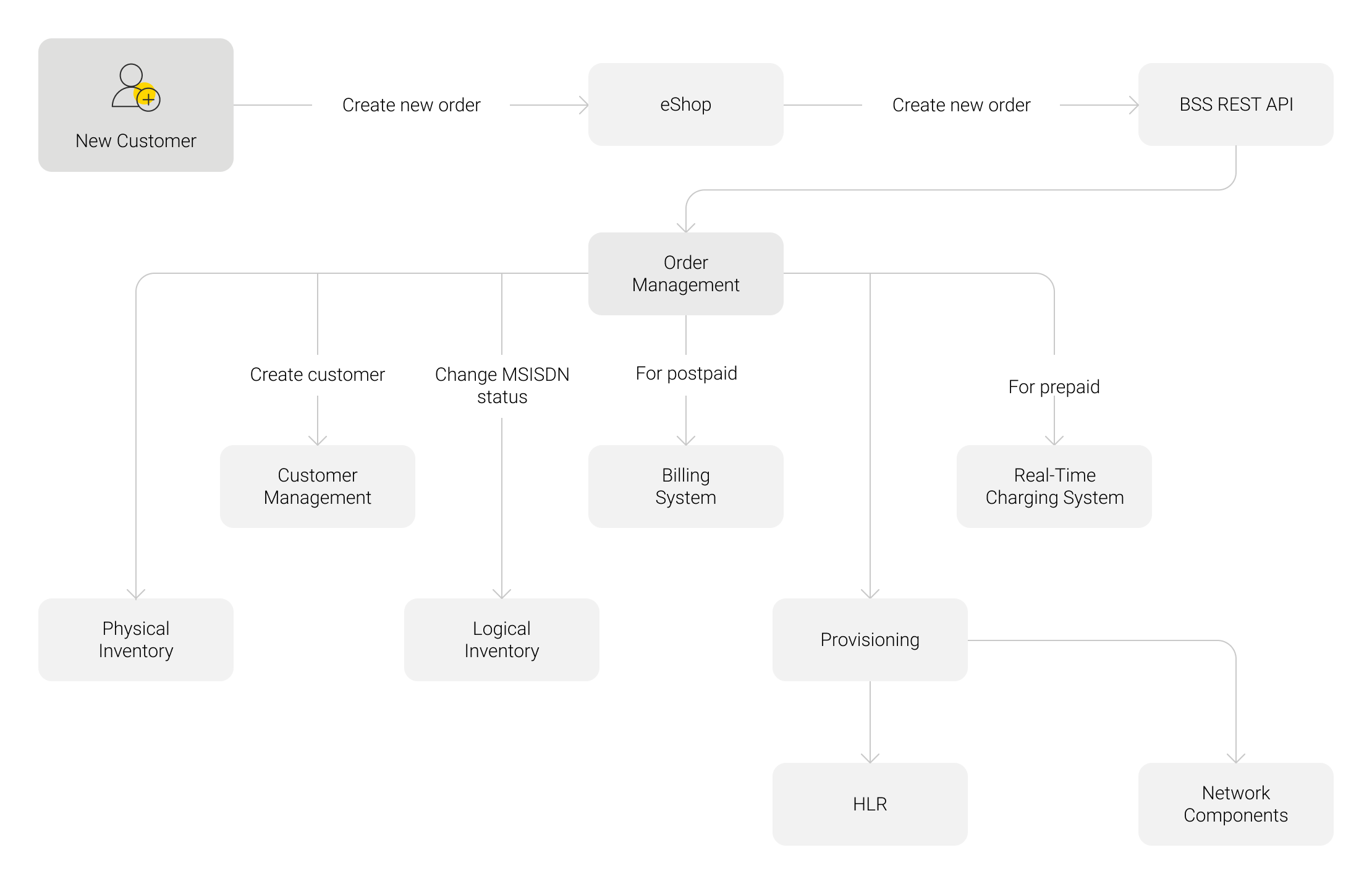
As you can see, this business process affected multiple BSS and OSS components:
- eShop – as the primary channel for customer interaction;
- Order management – orchestrates requests;
- Physical inventory – a stock of SIM cards at the office location;
- Logical inventory – changes the status of a SIM card and MSISDN from 'available' to 'in use';
- Customer management – creates new clients and subscription entities;
- Billing system – generates initial charges for new clients and subscription entities;
- Real-time charging system – charges for prepaid calls;
- Provisioning – sends information about new subscriptions to HLR and network components.
Preliminary architecture
All Telecom software components can be divided into three categories:
- BSS – covers business and client-facing activities;
- OSS – an intermediate layer that supports network components and binds them to BSS;
- Network – a network layer that heavily relies on network hardware.
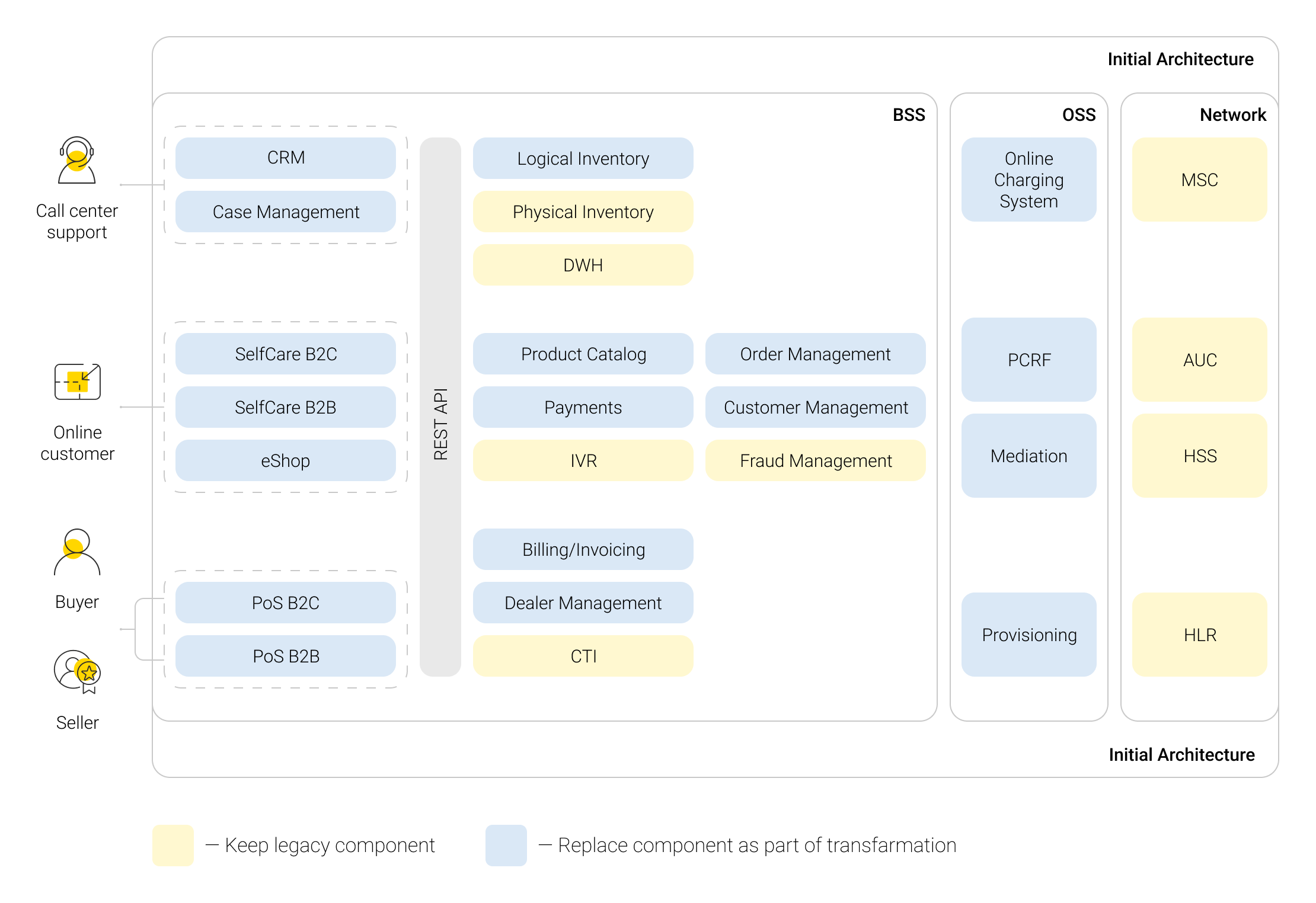
Channels:
- Point of sale B2C – allows sales specialists to sell new B2C subscriptions in offices;
- Point of sale B2B – allows the B2B department to sign new B2B contracts and create new subscriptions;
- eShop – sells SIM cards to new B2C clients online;
- SelfCare – a web channel for existing clients to manage their services;
- CRM – allows operators to view profiles of existing clients and manage their services;
- Case management – stores client support cases and interactions as part of the procedure for call center request processing.
Internal BSS components:
- REST API – a major REST API solution that reveals all BSS-related APIs for 3PP systems and channels;
- Billing/Invoicing – handles invoice generation and dunning/collection processes in case invoices were not paid (for postpaid clients);
- Product catalog – contains the descriptions of pricing plans and extra packages;
- Order management – handles order processing and orchestration over various systems;
- Logical inventory – stores SIMs and MSISDNs;
- Dealer management – is dedicated to working with franchise and external dealers that sell SIM cards or provide support;
- Payments – accepts payments from various sources (bank cards, autopayments, bank direct debit, etc.);
- Customer management – stores information about clients and subscriptions;
- Physical inventory – stores information about devices and SIM cards and their mapping in accordance with physical stocks;
- CTI (computer telephony integration) – allows call center operators to receive calls for support via their computers and immediately see the caller's CRM profile;
- IVR – an automated telephone system that uses pre-recorded messages to engage callers, allowing them to access information without a live agent;
- Fraud management – a system that monitors all client actions to identify and prevent malicious activity.
OSS components:
- Provisioning – sends information about new subscribers to the network;
- Mediation – collects CDRs (Call Definition Records);
- PCRF (Policy and Charging Rules Function) – controls the service quality and ensures QoS;
- Online Charging System – charges for prepaid calls.
Tender processing
Once the requirements of the tender were finalized and approved by the customer, Andersen's BSS telecom architecture experts assisted them with tendering. After carefully reviewing multiple companies, only two were selected for the final round.
As part of the last round, the shortlisted companies had a chance to present use cases concerning their platforms. This way, a deep understanding of all advantages and flaws was reached on the Telecom side. These efforts helped the customer to select the best final BSS vendor's solution with reasonable pricing.
The following advantages of the preferred solution were especially appealing to the business and helped to make the final choice:
- A BPMN-like engine in Order management enabling easy management of workflows without extra development;
- A fast and high-performance REST API that was TM Forum-compliant and easy to integrate;
- A modern CRM system with a proper UI/UX, allowing operators to see all subscription/client data in a single view and significantly decreasing the time needed to resolve client requests;
- A single product catalog making it possible to configure even complicated logic without extra development and providing for sophisticated eligibility rules;
- A mature billing system supporting credit notes and complicated taxation models and recording all data needed for financial reporting.
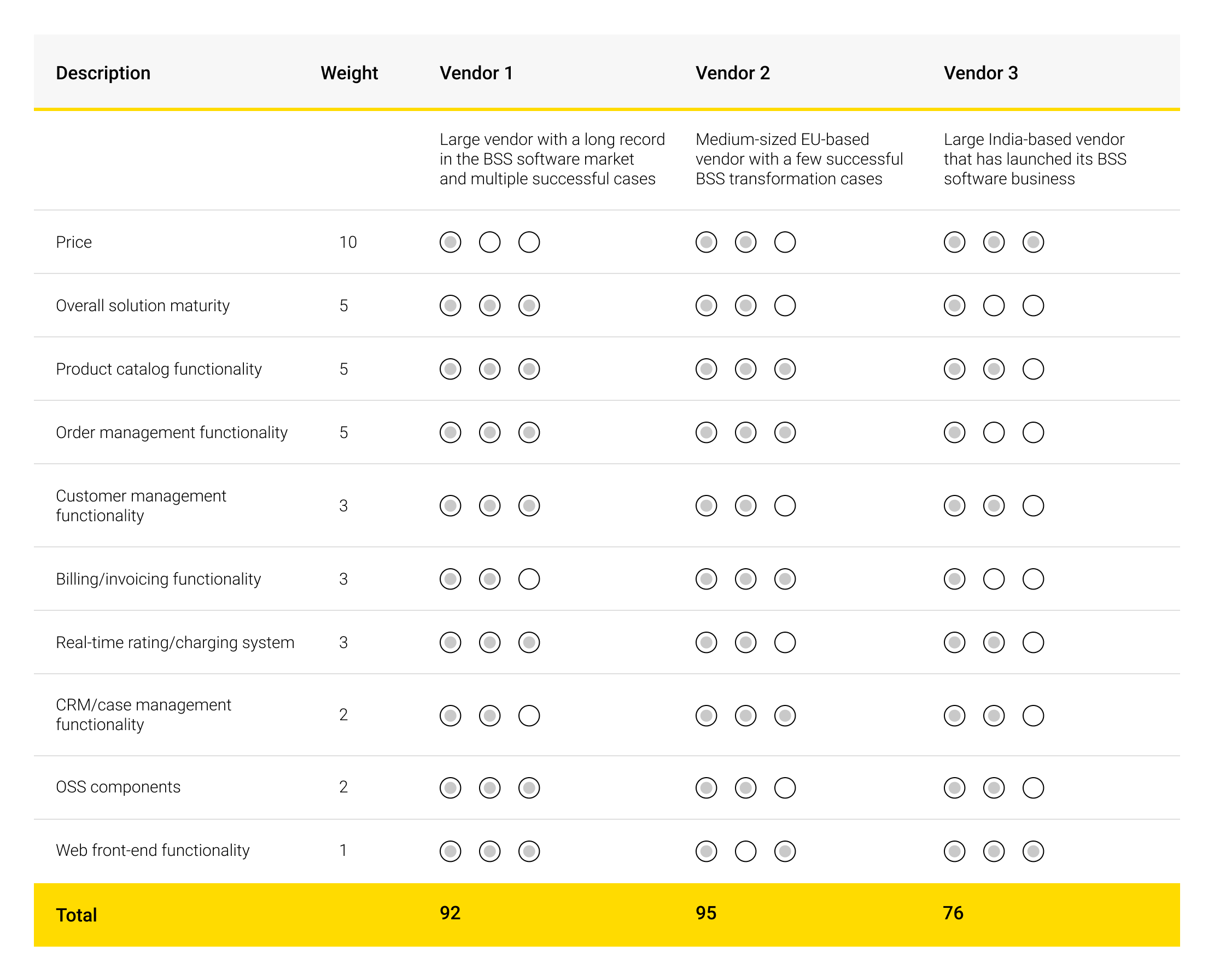
Based on careful analysis of the proposed BSS solutions for Telecom and their pros and cons, the operator made the best choice.
The selected vendor was chosed as the customer's primary BSS vendor due to its overall high compliance with business and technical requirements, experience in similar BSS cases, and reasonable prices. Since its score in Web Front channels was low, it was agreed that Andersen would take over a portion of the work and develop the SelfCare and eShop systems so that the vendor could concentrate on the primary BSS components.
Due to the high workload of the BSS vendor and their tight project schedule, we also took over some Front-end components, which contributed to the successful implementation of the project on time.
The final architecture featured some minor changes compared to the initial proposal. As you can see below, SelfCare and eShop web channels were added to Andersen's scope.
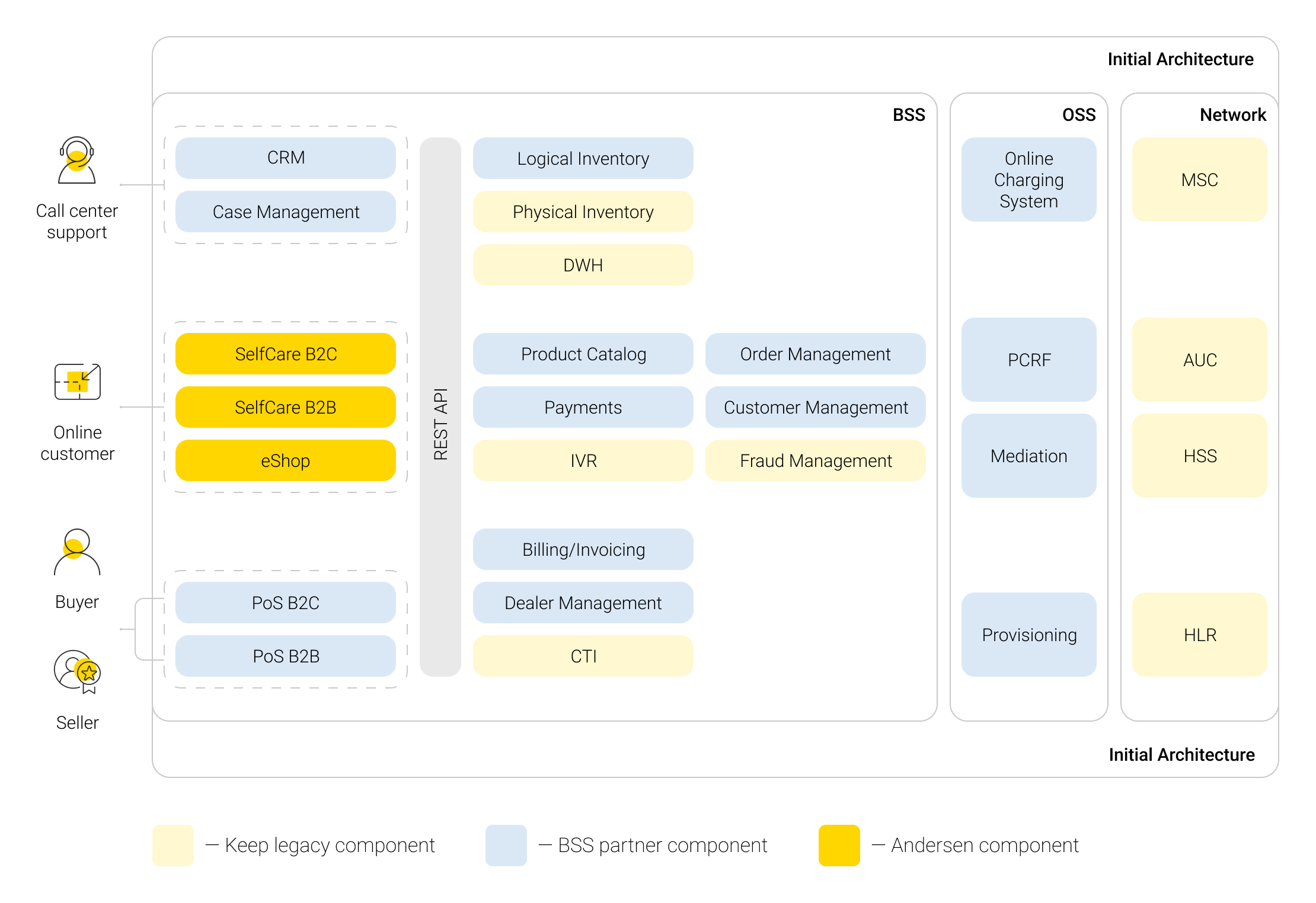
Andersen's Front-ends
Andersen worked on the development of web Front-ends for the B2C/B2B SelfCare and online shop. All web channels were supposed to provide effective and unified customer journeys that would deliver an omnichannel experience.
Design
In order to create a unified design for all web channels and make sure they're in sync with the customer's branding policies, our UI/UX and design team developed a brand book with primary design and functional elements in conformity with the customer's colors and identity. After that, we created a library of common user controls and elements to be reused all over the website to ensure correct brand representation.
Authentication/Authorization
A dedicated authorization microservice was developed by our team to support scenarios for the end-client.
The microservice provides a Web UI for clients to input their login and password information or authenticate via other means:
- One-time password sent via SMS;
- Social networks;
- Password reset via SMS or email.
By following industry standard protocols, OpenID/OAuth2, we ensured the safety and robustness of authentication flows.
B2C SelfCare
SelfCare is a website that allows existing Telecom clients to get information about their current services, balances, products, and fees. It enables standard functionalities for Telecom operators, such as:
- Managing packages and pricing plans;
- Viewing itemization-related and financial information;
- Viewing and managing client information and settings.
In order to fulfill all customer requirements, we needed to implement extra advanced functionalities:
- Managing shared bundle allowances (e.g., data package split between family members);
- “Build your own package” constructor allowing a client to select custom allowance amounts;
- Controlling Telecom services for Friends & Family;
- Top Up/Payment functionalities, including auto-payment setup;
- Targeted upsell and downsell prevention promotions.
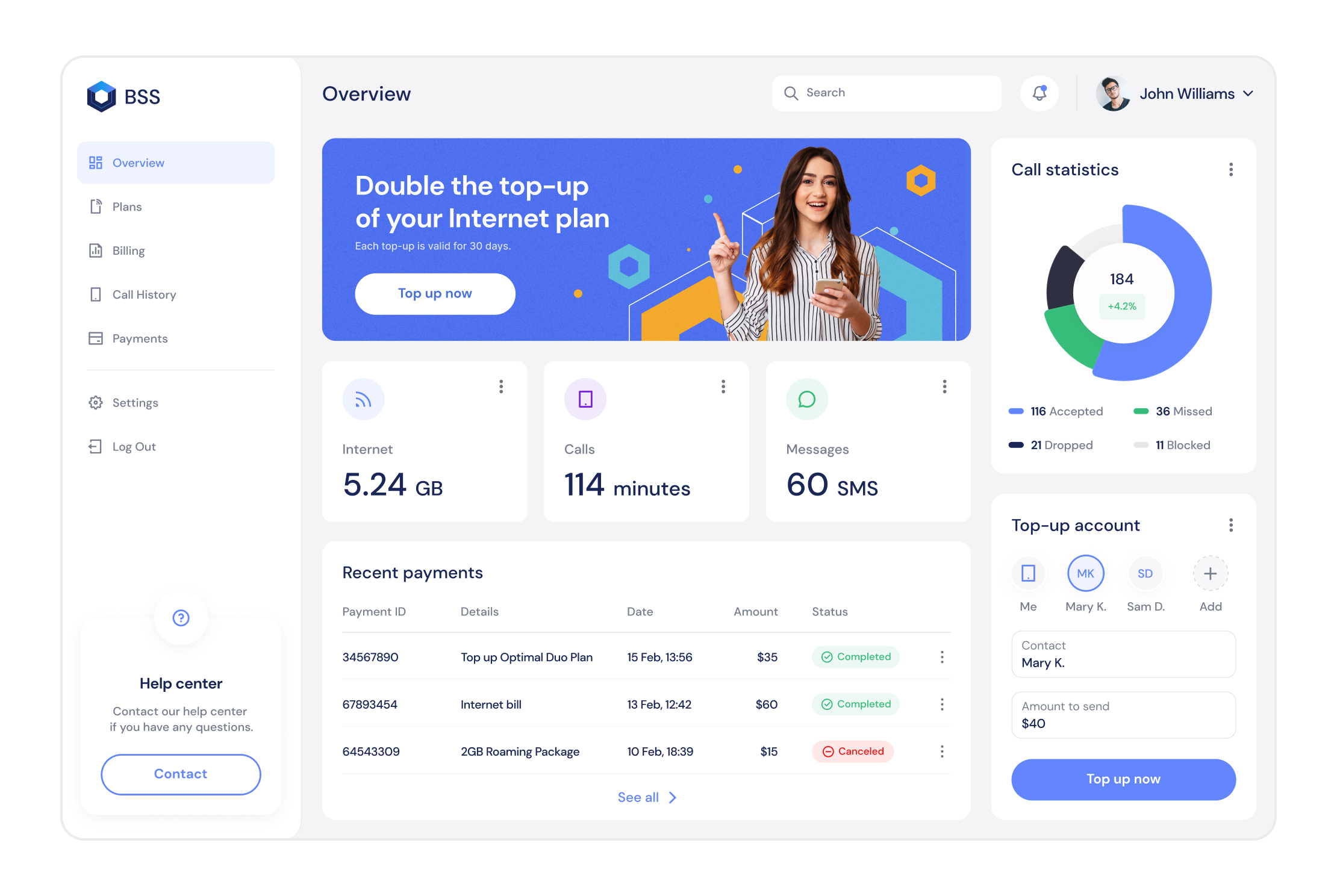
B2B SelfCare
B2B SelfCare is a channel for the company's representatives to manage B2B Telco services.
It enables additional functionalities on top of B2C SelfCare; that's why it was agreed to move this channel into a separate app.
A single representative can manage multiple subscriptions simultaneously, which means managing packages and pricing plans of, for instance, all subscribers. This greatly simplifies the work of the operator's B2B support team, as a representative can do many operations by themselves. Additionally, B2B SelfCare gives the possibility to control company-level bills, credit notes, payments, and other information.
eShop
eShop allows new leads to view a list of Telco offers provided by the operator and buy new SIM cards online. The following functionalities became vital for the operator's business:
- The eSIM service allows clients to buy prepaid eSIM cards fully online and start using them within minutes of the transaction. No physical SIM card is needed – the client receives a QR code that they then scan;
- Organizing sales of the operator's phones and accessories, both individually and as contract bundles. The eShop is integrated with the stock management and delivery partner systems to enable store pickup or delivery;
- Contracts for paying for devices in installments allow Telecom clients to buy devices with special pricing plans and discounts;
- Multiple payment methods, such as balance payments, bank cards, or cash payments during pickup;
- Due to integration with the product catalog, the eShop can show special products only eligible from this channel;
- A client can select their MSISDN, including a premium number for an additional fee;
- MNP cases (migration from other operators) are supported within the standard acquisition flow.
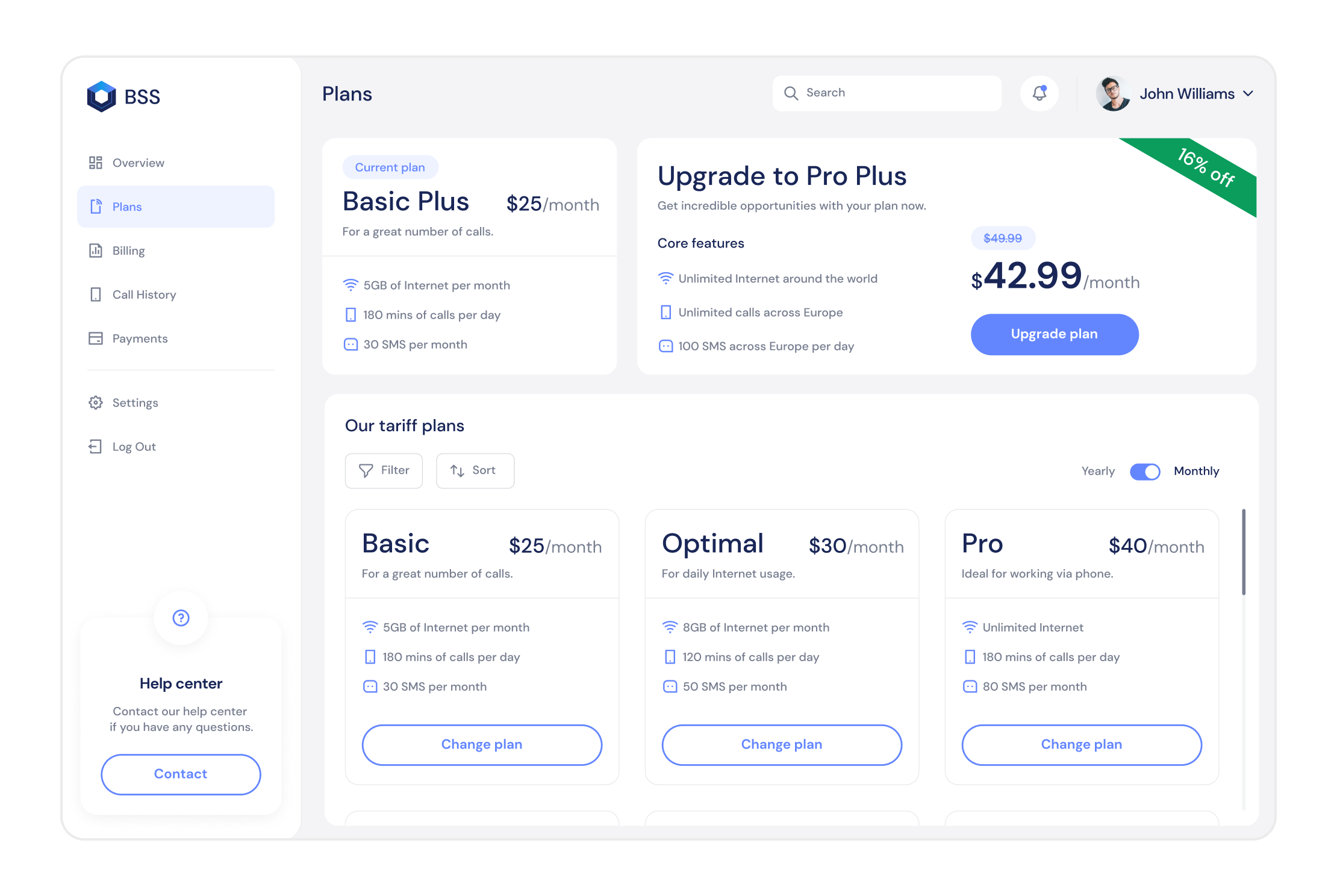
Migration approach and planning
It took Andersen 18 months to deliver the BSS transformation solution and all the needed customizations, ensure that all the components were properly integrated, and perform end-to-end testing. The transformation was planned as a "Big Bang" with all the subscribers to be migrated overnight.
Big Bang migrations have an advantage over Phased migrations, as they do not mandate a coexistence period – i.e., when both old and new stacks have to be supported. Since the number of subscribers was not that large, we selected the overnight migration approach as the simplest option.
A dedicated cutover manager was appointed to ensure the successful client migration and overall cutover process. The manager was responsible for a 400-point cutover plan that described all needed activities, in every affected system, required to switch to the new BSS stack. A few cutover rehearsals were planned and successfully executed to instill confidence in the customer that the solution was ready for deployment. After that, we were given the final green light for the Go Live phase.
Transformation results
All migration and cutover activities were successfully executed overnight as planned. Due to extensive planning, testing, and multiple rehearsals, it became possible to finish the migration project without negatively affecting the client experience or causing critical issues.
As a result, the new BSS stack proved to be robust, efficient, and agile. The customer was fully satisfied with the resulting BSS transformation solution as it allowed them to achieve their goals in full.
- BSS license costs have decreased by 35%;
- Operations costs have decreased by 20%;
- The average Call-to-Resolution time for the call center has decreased by 15%;
- TTM for simple Telecom product initiatives has decreased by 50%.
Client engagement across digital channels has significantly increased:
- 35% more orders are placed via eShop;
- 20% more active users of SelfCare.
Improved stability has ensured that 99.8% of orders are handled successfully within the SLA timings. The performance of new subscription issuance procedures and package activation use cases have improved by 20% and keep on working consistently and quickly even under high loads.No Severity 1 or 2 Issues after the stabilization period.
Let's talk about your IT needs
What happens next?
An expert contacts you after having analyzed your requirements;
If needed, we sign an NDA to ensure the highest privacy level;
We submit a comprehensive project proposal with estimates, timelines, CVs, etc.
Customers who trust us
